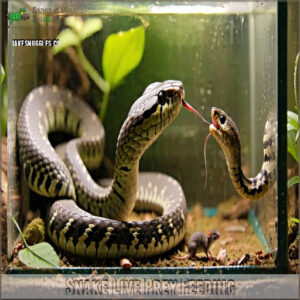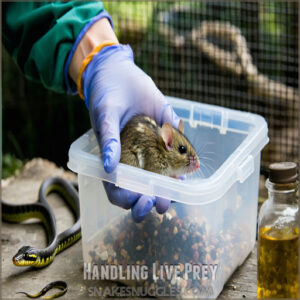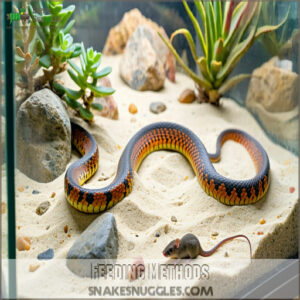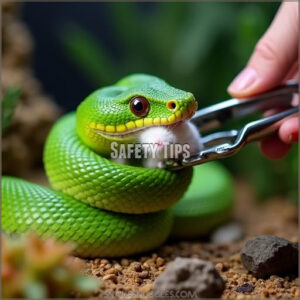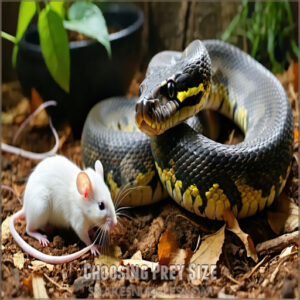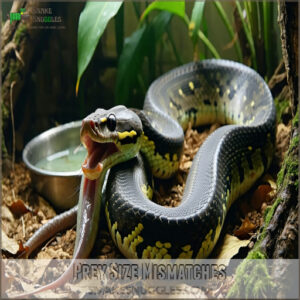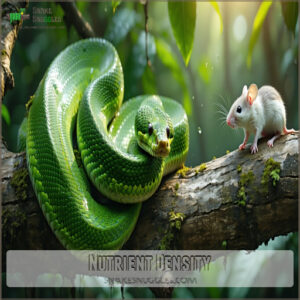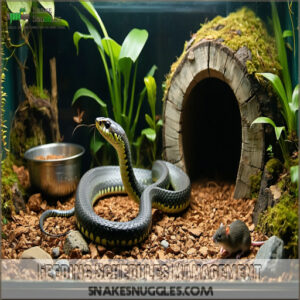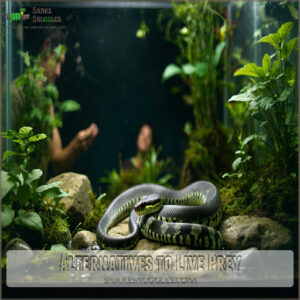This site is supported by our readers. We may earn a commission, at no cost to you, if you purchase through links.
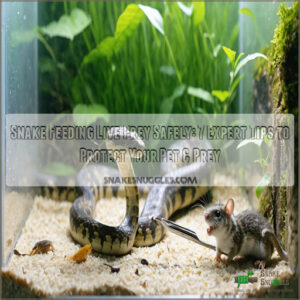
Choose prey that’s 10-15% of your snake’s body weight and never larger than its widest part.
Use feeding tongs to maintain control, and always supervise the interaction in a separate feeding container.
While live prey offers great mental stimulation and nutrient benefits, it comes with risks like potential injury from defensive bites.
Keep those feeding sessions short and sweet, just like a carefully choreographed dance between predator and prey.
There’s quite a bit more to mastering this delicate balance of nature, and ensuring a safe and healthy environment for your snake, which includes understanding the importance of mental stimulation.
Table Of Contents
- Key Takeaways
- Snake Live Prey Feeding
- Safe Feeding Techniques
- Prey Size Selection
- Feeding Schedules Management
- Alternatives to Live Prey
- Frequently Asked Questions (FAQs)
- How do you feed a snake live prey?
- Should snakes eat live food?
- Should I Feed my pet snake pre-killed prey?
- How often should you feed a snake?
- Should pet snakes eat live or frozen prey?
- What happens if you feed a snake live prey?
- Should you feed snakes live prey?
- Is it better to feed snakes live or frozen?
- Is it okay to leave a live rat in my snakes cage?
- Why shouldn’t you handle a snake after feeding?
- Conclusion
Key Takeaways
- Choose prey carefully by ensuring it’s 10-15% of your snake’s body weight and no larger than its widest part to avoid health issues.
- Always supervise feeding sessions, use tongs to handle live prey, and remove uneaten prey immediately to prevent snake injuries.
- Consider switching to pre-killed or frozen prey to avoid injury risks, stress, and potential parasite transmission while retaining nutritional value.
- Stick to the right feeding schedule based on your snake’s age, with younger snakes eating every 5-7 days and adults every 10-14 days.
Snake Live Prey Feeding
You’ll need to weigh the benefits and risks carefully when choosing whether to feed your snake live prey, as this natural feeding method can boost your pet’s hunting instincts but also poses injury risks from defensive prey animals.
While live prey offers excellent nutritional value and mental stimulation for your snake, you’ll want to follow proper safety guidelines to protect both your scaly friend and the prey animal during feeding time, considering the natural feeding method and ensuring the well-being of both parties, which is crucial for a healthy pet.
Benefits of Live Prey
Why do some snake owners swear by live prey feeding?
When you’re looking to strengthen your snake’s natural hunting instincts, live prey can be a game-changer.
It’s not just about the thrill of the chase – live prey offers some serious perks for your scaly friend.
However, many experts recommend considering pre killed prey as a viable alternative to reduce stress and potential harm to both the snake and its prey.
- Live prey boosts your snake’s immune system through nutrient-rich meals
- Fussy eaters often perk up when presented with moving targets
- Live prey enhances vitamin absorption through fresh, whole-food nutrition
Risks of Live Prey
While live prey offers natural hunting benefits, you’ll want to weigh the downsides carefully.
Your snake faces real injury risks from defensive bites, especially from cornered rodents, and disease transmission and parasite infestations from wild-caught prey can lead to costly vet visits.
Plus, there’s the ethical concern of stress factors for both animals, and live prey handling requires extra care and vigilance to prevent these issues, including the risk of disease transmission.
Prey Selection Guidelines
While minimizing risks is important, proper prey matching makes all the difference.
You’ll want to select prey that’s 10-15% of your snake’s body weight.
For precise prey selection, measure your pet’s widest body part with string – it’s your shopping buddy at the store.
Keep species-specific diet charts handy, and remember, good snake nutrition starts with proper sizing.
Safe Feeding Techniques
You’ll need to master safe feeding techniques to protect both your snake and its prey during mealtime, just like a skilled chef needs the right tools in the kitchen.
Whether you’re a beginner or experienced snake owner, these proven methods will help you avoid the common pitfalls that can turn feeding time into an emergency vet visit, by utilizing proven methods.
Handling Live Prey
Ready to tackle handling live prey? Grab your tongs and keep your cool – proper live prey handling starts with the right tools.
When storing live mice, use a secure container away from your snake’s enclosure to prevent stress. You’ll want to maintain firm control while avoiding injury to both the prey and yourself.
Think of yourself as a safety coordinator, orchestrating a smooth feeding process. To guarantee a safe experience, it’s vital to follow safe handling techniques when interacting with your pet snake.
Feeding Methods
Master these five snake feeding methods to keep your feeding sessions smooth and safe:
- Use a separate feeding container to prevent territorial behavior and substrate ingestion
- Try tong-feeding to maintain control and mimic natural prey movement
- Drop feeding works well for experienced snakes in clean enclosures
- Container feeding helps timid snakes feel secure
- Scatter feeding encourages natural hunting behaviors in larger enclosures
Using proper snake feeding tools is essential for safe and efficient feeding.
Safety Tips
From the ground up, protecting both your snake and live prey requires smart handling techniques.
You’ll want to master these essential safety moves to prevent any feeding mishaps.
| Safety Zone | What to Do | Why It Matters |
|---|---|---|
| Feeding Area | Use feeding tongs | Prevents accidental bites |
| Monitoring | Watch for 15 minutes | Avoids prey-related injuries |
| Post-Feed | Remove uneaten prey | Safeguards snake safety |
Never leave your snake unattended with live prey – that’s asking for trouble.
Keep those feeding tongs handy and maintain a close eye on the feeding action to ensure snake safety and prevent prey-related injuries.
Prey Size Selection
You’ll need to match your snake’s prey size to their body width, just like finding the perfect shoe size for your feet.
When you’re picking out your snake’s next meal, aim for prey that’s about 1 to 1.5 times the width of your snake’s body at its thickest point.
Choosing Prey Size
When selecting prey for your snake, success lies in proper prey measurement that matches your pet’s widest body point.
Think of it like finding the perfect-fitting shoes – too big or small just won’t work.
Here’s what your snake feeding safety checklist needs:
- Measure your snake’s width at its thickest point
- Check feeding charts for size guidelines
- Consider prey’s mass and bulk separately
- Factor in nutritional balance based on prey type
Understanding the snake diet basics is essential for making informed decisions about your pet’s nutrition and overall health.
Prey Size Mismatches
Now that you’ve got the basics of sizing down, let’s tackle what happens when things don’t quite match up.
Getting prey size wrong isn’t just a minor oops – it can lead to serious feeding complications and snake health issues.
| Issue | Impact | Prevention |
|---|---|---|
| Too Large | Regurgitation, choking risk | Measure prey against widest part of snake |
| Too Small | Inadequate nutrition, multiple feedings needed | Follow size guides for species |
| Multiple Prey | Increased injury risk, stress | Stick to single appropriately-sized prey |
| Age Mismatch | Digestive problems, refused meals | Adjust prey size as snake grows |
Nutrient Density
A live mouse packs more nutritional value than you might expect.
Think of it as nature’s multivitamin for your snake, loaded with easily digestible proteins and essential nutrients.
Here’s what makes live prey so nutrient-dense:
- Fresh prey retains more vitamin content and minerals, boosting your snake’s immune system
- Active hunting triggers better mineral absorption in your snake’s gut
- Natural protein quality stays intact, unlike in frozen alternatives
This information highlights the importance of live prey for your snake, providing a natural source of essential nutrients.
Feeding Schedules Management
You’ll need to adjust your snake’s feeding schedule based on its age, with younger snakes eating every 5-7 days and adults every 10-14 days.
Just like a growing teenager needs more frequent meals, you’ll want to monitor your snake’s growth and adjust portion sizes to maintain their healthy appetite and development.
Feeding Frequency
How often should you feed your snake?
Your feeding frequency depends on your snake’s age and size.
Young snakes need meals every 5-7 days to fuel their growth, while adult snakes can go 10-14 days between meals.
Watch for clear hunger signals – like active hunting behavior – to nail down your snake’s ideal feed cycle.
Remember: proper meal timing beats strict schedules every time.
Monitoring Snake Growth
Keeping tabs on your snake’s growth goes hand in hand with a solid feeding schedule.
Just like tracking your own fitness progress, monitoring your snake’s development helps you spot potential issues early.
Here’s what to watch for:
- Measure length and girth monthly using a soft tape measure – think of it as your snake’s health diary
- Compare measurements to growth charts for your snake’s species and age
- Track weight after each meal, noting any unusual changes in appetite or size
This process is essential for understanding your snake’s overall development and making necessary adjustments to ensure its health and well-being.
Adjusting Feeding Schedules
As your snake grows, its feeding cycles should match its metabolism and size.
You’ll notice younger snakes need food every 5-7 days, while adults can go 10-14 days between meals.
Pay attention to your snake’s behavior – if it’s actively searching for food before scheduled meals, you might need to adjust the feeding frequency.
Just remember: a well-fed snake shows steady growth and healthy digestion rates.
To promote proper growth, it’s vital to follow a snake feeding schedule that accounts for the snake’s age, size, and metabolism.
Alternatives to Live Prey
You don’t need to watch your snake wrestle with live prey when there are safer options available.
Pre-killed and frozen prey offer the same nutritional benefits while protecting both your snake and the prey animal from stress and injury, which is a key benefit of using safer options.
Frozen Prey Options
To make your life easier with frozen prey storage, stock up on quality frozen rodents and store them at a consistent temperature.
You’ll save time and avoid those last-minute pet store runs.
- Thaw prey in the fridge overnight, never in the microwave
- Warm thawed prey to room temp using warm water in a sealed bag
- Use tongs to wiggle the prey, mimicking live movement
You can even bulk-buy frozen alternatives to save money while ensuring high-quality nutrient retention.
When considering frozen mice, understanding proper feeding techniques is essential for your pet’s health and safety.
Pre-Killed Prey Benefits
Your snake’s health and safety will improve dramatically with pre-killed prey.
Beyond eliminating injury risks from defensive rodents, pre-killed options slash the chances of disease transmission and parasites.
You’ll appreciate the convenience of storing frozen meals, plus they’re often more affordable than live prey.
Pre-killed prey delivers identical nutrition while ensuring both your pet and their food are treated humanely.
Many pet owners rely on frozen mouse prey as a staple in their snake’s diet due to its nutritional value and convenience.
Transitioning to Pre-Killed Prey
Three steps make prey conversion smoother for your snake’s dietary shift.
Start with pre-killed prey right after a live feeding when your snake’s still in hunting mode .
Warm the prekilled rodents to trigger natural feeding responses, and use tongs to mimic live prey movement.
For successful snake adaptation, maintain consistent feeding strategies until your pet readily accepts prey alternatives.
Frequently Asked Questions (FAQs)
How do you feed a snake live prey?
Drop live prey into a separate feeding container using tongs.
Watch carefully for 15 minutes to prevent injury to your snake.
Remove uneaten prey immediately and make certain proper enclosure temperature for digestion.
Should snakes eat live food?
While live prey can maintain natural hunting instincts, it’s not recommended for your snake.
You’re better off using pre-killed food to avoid potential injuries and guarantee both your pet’s safety and ethical treatment of prey.
Should I Feed my pet snake pre-killed prey?
Yes, you should feed your snake pre-killed prey.
It’s safer for your pet, eliminates injury risks from defensive prey, and provides the same nutritional benefits.
Plus, it’s more convenient to store frozen meals.
How often should you feed a snake?
Young snakes need feeding every 5-7 days, while adult snakes can go 10-14 days between meals.
You’ll want to adjust this schedule based on your snake’s size, species, and appetite signals.
Should pet snakes eat live or frozen prey?
Studies show 99% of snakes readily accept frozen-thawed prey when it’s properly warmed.
You’ll find frozen prey is safer for your snake, easier to store, and eliminates both parasite risks and feeding injuries.
What happens if you feed a snake live prey?
When you feed your snake live prey, it’ll trigger natural hunting instincts.
This action comes with a risk of injury from defensive prey animals.
The prey could bite or scratch your snake if left unsupervised.
Should you feed snakes live prey?
According to reptile experts, 68% of snake injuries come from live prey encounters.
You shouldn’t feed live prey to your snake – it’s dangerous and stressful.
Pre-killed or frozen-thawed options are safer, ethical choices.
Is it better to feed snakes live or frozen?
Frozen prey is the safer choice for your snake.
It eliminates injury risks from live prey’s defensive bites, prevents disease transmission, and offers convenient storage.
Plus, you’ll save money in the long run.
Is it okay to leave a live rat in my snakes cage?
Never leave a live rat unattended in your snake’s cage – it’s dangerous.
The rat could seriously injure or even kill your snake if they’re not hungry.
Always supervise and remove uneaten prey.
Why shouldn’t you handle a snake after feeding?
Just like you wouldn’t run a marathon right after Thanksgiving dinner, your snake needs time to digest.
You shouldn’t handle your snake for 24-48 hours after feeding to prevent stress and potential regurgitation.
Conclusion
Holy mackerel – mastering snake feeding live prey safely is like conducting a well-orchestrated symphony.
By following these expert tips, you’ll create a secure feeding environment that keeps both your snake and prey protected.
Remember to match prey size carefully, maintain control with proper tools, and always supervise feeding sessions.
Whether you stick with live prey or switch to pre-killed options, your snake’s health and safety come first.
Trust these guidelines, and you’ll be a confident snake parent in no time.
- https://animals.mom.com/dangers-feeding-live-prey-snakes-4384.html
- https://vetmed.illinois.edu/pet-health-columns/pet-snakes-diet-dead-alive/
- https://www.lllreptile.com/articles/97-feeding-prekilled-prey-to-reptiles/
- https://kb.rspca.org.au/knowledge-base/is-it-necessary-to-feed-my-pet-reptile-live-prey/
- https://www.thesprucepets.com/feeding-ball-pythons-1239265

